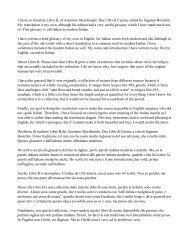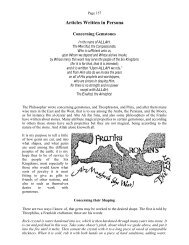How to Milk an Almond Stuff an Egg And Armor a Turnip A ...
How to Milk an Almond Stuff an Egg And Armor a Turnip A ...
How to Milk an Almond Stuff an Egg And Armor a Turnip A ...
You also want an ePaper? Increase the reach of your titles
YUMPU automatically turns print PDFs into web optimized ePapers that Google loves.
ut that no period recipes more elaborate th<strong>an</strong> “fried in oil <strong>an</strong>d with salt <strong>an</strong>d pepper” are known.<br />
142<br />
Capsicum Peppers<br />
The term “pepper” refers <strong>to</strong> two entirely different groups of pl<strong>an</strong>ts. The spice pepper, both<br />
black <strong>an</strong>d white, is the fruit of <strong>an</strong>y of a group of related Old World trees <strong>an</strong>d is routinely<br />
mentioned in period cookbooks. The capsicum peppers, which include both hot peppers (chili,<br />
cayenne, paprika, etc.) <strong>an</strong>d sweet or bell peppers, are New World. According <strong>to</strong> the OED, the first<br />
English use of the word “chili” is in 1662. According <strong>to</strong> Dewitt <strong>an</strong>d Gerlach, there is a Sp<strong>an</strong>ish<br />
reference <strong>to</strong> hot peppers from the New World in 1493; apparently the seeds had been brought<br />
back by Columbus. They assert that peppers are mentioned in Italy in 1526 <strong>an</strong>d in Hungary (in a<br />
list of foreign seeds pl<strong>an</strong>ted in a noblewom<strong>an</strong>’s garden–as “Turkish Red Pepper”) in 1569. They<br />
also say that “according <strong>to</strong> Leonhard Fuchs, <strong>an</strong> early Germ<strong>an</strong> professor of medicine, chiles were<br />
cultivated in Germ<strong>an</strong>y by 1542, in Engl<strong>an</strong>d by 1548, <strong>an</strong>d in the Balk<strong>an</strong>s by 1569.” Assuming that<br />
both the dates they give <strong>an</strong>d those they attribute <strong>to</strong> Fuchs are correct, it sounds as though chile<br />
peppers, at least, had spread through much of Europe by 1600. This does not, however, imply that<br />
they were in common use. We have not found <strong>an</strong>y period recipes using capsicum peppers, nor<br />
period references <strong>to</strong> their being served at feasts.<br />
Be<strong>an</strong>s<br />
Some be<strong>an</strong>s are New World, some Old World. Crosby lists “lima, sieva, R<strong>an</strong>goon,<br />
Madagascar, butter, Burma, pole, curry, kidney, French, navy, haricot, snap, string, common, <strong>an</strong>d<br />
frijole be<strong>an</strong>” as Americ<strong>an</strong> <strong>an</strong>d mentions that soybe<strong>an</strong>s are Old World. Broad be<strong>an</strong>s, aka fava<br />
be<strong>an</strong>s, are also Old World, as are lentils, chickpeas <strong>an</strong>d the black-eyed be<strong>an</strong> (Vigna unguiculata).<br />
According <strong>to</strong> Crosby, the haricot be<strong>an</strong> “was in Europe by at least 1542, for in that year the<br />
bot<strong>an</strong>ists Tragus <strong>an</strong>d Leonard Fuchs described <strong>an</strong>d sketched it. It was probably grown in<br />
appreciable qu<strong>an</strong>tities in Fr<strong>an</strong>ce by the end of the century; otherwise, why would the Englishm<strong>an</strong>,<br />
Barnaby Googe, write of it as the 'French be<strong>an</strong>' in 1572?” There is also one reference <strong>to</strong> kidney<br />
be<strong>an</strong>s <strong>an</strong>d French be<strong>an</strong>s being grown in the Middle East in the 1570's (Crosby). Some Old World<br />
be<strong>an</strong>s were known in Asia but not, as far as we know, in Europe or the Middle East; these include<br />
soy be<strong>an</strong>s in China <strong>an</strong>d mung be<strong>an</strong>s in India.<br />
Pe<strong>an</strong>uts<br />
With pe<strong>an</strong>uts as with corn, there has been some controversy over origin. The OED describes<br />
them as native <strong>to</strong> the New World <strong>an</strong>d West Africa. Higgins discusses the evidence at some length<br />
<strong>an</strong>d concludes that the pe<strong>an</strong>ut is a New World pl<strong>an</strong>t introduced in<strong>to</strong> West Africa early in the<br />
sixteenth century, probably by the Portuguese, <strong>an</strong>d in<strong>to</strong> the East Indies at about the same time,<br />
probably by both the Portuguese <strong>an</strong>d the Sp<strong>an</strong>ish. Europe<strong>an</strong> explorers in Africa a century later<br />
observed pe<strong>an</strong>uts, maize, cassava, <strong>an</strong>d <strong>to</strong>bacco, <strong>an</strong>d concluded that they all were native. He cites<br />
Chevalier, Auguste, “His<strong>to</strong>ire de L'Arachide.,” Rev. Bot. Appl. & d'Agr. Trop. 13 (146 & 147):<br />
722-752. According <strong>to</strong> Cosby, pe<strong>an</strong>uts were grown in China in the sixteenth century.<br />
There is some archeological evidence for pe<strong>an</strong>uts in China at a much earlier date, briefly<br />
discussed by Simoon; my conclusion from his discussion is that the evidence is probably wrong.<br />
The OED reports no uses of “pe<strong>an</strong>ut” (or “groundnut” as a synonym for “pe<strong>an</strong>ut”) prior <strong>to</strong> the<br />
eighteenth century.





